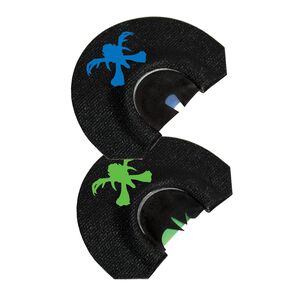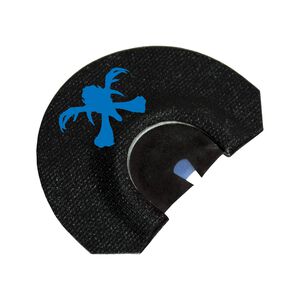Troy Ruiz will take you to the next step of learning and mastering the mouth call. One of the most fundamental noises you can make as a turkey caller is a hen yelp. Troy will get you started on yelping with a mouth call.
Yelping is one of the fundamental aspects of turkey calling. If you breakdown the yelp, it includes the fundamentals for almost all vocalizations. The yelp is the basic turkey sound, and toms, hens, and jakes all do it. It’s essentially saying “Here I am” in turkey speak. There are a couple of different types of yelps, and we’ll go over what they mean and when to use them.
EXCITED YELP
The excited yelp is just a change in cadence from your regular 3-8 note yelp. It would be the difference in saying “Hey ya’ll I’m over here” to “HEY. HEY. HEY COME HERE QUICK”. It’s a great way to get a longbeard fired up and headed in your direction. Mix in Cuts with excited yelping, and look for Mr. April coming to kick the hinges off. A great diaphragm call for getting fast on and mixing in cuts with excited yelps is the Razor Hooks with a Bat Cut.
TREE YELP
The tree yelp is the sound made by a hen while at roost in the tree. This is a more of a content call, as she is waking up and just starting to see where everyone is located. It is a great call to use when trying to coax a gobbler off the limb to your position. The goal in a lot of roost situations is to play a little hard to get. If you start hammering a gobbler on the limb with cuts, and exciting yelping, he will often either stay up in the tree and gobble, waiting for the hen he heard to walk within eyesight before pitching down. Or he’ll pitch down right by the base of the tree waiting for his lady friend to arrive. Therefore a tree yelp works great, because it gives away your position without being too committed.
VIDEO TRANSCRIPTION
Primos Hunting- Stream the Language. Hey folks, Tory Ruiz here from Primos again. Since we're sitting here talking about how to blow on a TURKEY CALLS especially a mouth call one thing I want you to understand and to know that what you're working with here is a true musical instrument. It takes air, it takes tongue pressure and it also takes air control. Just like in a duck call, just like in a trumpet, just like in a saxophone, this is a musical instrument to say the least. Some people look at it as a turkey call, but it's a musical instrument. We talked about the gag reflex in our first segment and how to get past it and if you do get past the gag reflex or you don't even have a gag reflex that's perfect.That means you're well on your way, because in my mind you got past one of the most difficult things you can deal with when trying to learn how to blow Mouth Calls. People always say “How can I learn to get a sound? I'm struggling with getting the sound. I'm doing this I'm doing that” a lot of times honestly it truly depends on the call that you're using. What I have here is a different array of calls I have the limb hanger which is a simple two-reed call, with no cut, two reeds of latex. Very very simple call with no cuts in it, this is actually a three reed mouth call and very small frames on the hacked off series with the back cut, this is a three reeded call and this is also a three reeded call, my recommendation is put these aside and the very beginning stages don't try to sound like one of those guys here on stage. Try to sound like a turkey getting their first note, think of yourself as a pult, you're a young turkey. What do I have to do to make the sound? Well very simple, we got past the gag reflex the very next thing is just getting air to go over the top of the call. The way it works, the way of turkey call works is you're pushing air right down the center of the call and over that Reed and causing those reeds to vibrate that's where your sound comes from across the top of the reed. So let's put the call back in our mouth, get it situated and what we want to do is a simple [lets out breath] what I do, versus where a lot of people do in in turkey calling : I huff you know everybody says I want to learn how to blow a turkey call, well you're really not blowing a turkey call you're not there's people that try that and can't get a single sound out of the call because you're not sending that air right over the top of the call. You want to huff, you want hot air to go over that call. The way to tell if you're getting hot air out of your body stand in front of a mirror and just blow, if you just blow like this I promise you it's cool air and it's not going to fog up a mirror but if you huff, that's hot air because it's coming from deep within its air that is coming from your diaphragm then from the bottom of your lungs and it's good hot air coming from the center of your body which causes that right sound that you have to have. So let's first learn how to huff, call in your mouth get situated and just get a sound just huff across the call. Now what you'll notice is my tongue sits on the call just like this so this is my tongue and my hand is my jaw so basically my tongue is here and I'm going my jaw is giving me tongue pressure to push up against that call which takes that air and focuses it right down the center of the call causing these reeds to vibrate. If you've trimmed the tape perfectly you have no air escaping out of the sides and all your air is focused right down the center of the call. So let's try that again, low pressure watch my jaw moving you hear it go up [Music] it sounds terrible. Sounds like a dog getting slammed in the car door, but you made it. If you got to that point you got a sound, the key there is get the sound and guess what? Don't try to yelp right away ride around in your truck if you're going to yelp at your house, make sure your wife and your kids aren't home that way they don't throw your calls away when you're at work. Practice keeping that sound and getting that sound and being able to control that sound controlling the sound is all based on tongue pressure. We'll go a little further in the next segment but let's just practice I want you to practice two or three days on just keeping that sound. I say hut, everybody uses a different word, I say hut and that's my tongue in my jaw cutting that air off. This is what it sounds like with the call[turkey sound] now the control that sounds is going to put more pressure on the call to make sure that that air stays in one spot. So I give it more pressure, basically my tongue is sitting on on the very bottom of that call and the air is going between my tongue and the roof of my mouth and it's going right across the top of that call which gives you that one solid note and that's the notes you're looking for. So practice air control getting that first sound and then air control once you get a good solid sound we'll go into the next segment and I'll teach you how to make the beginning start the start or the beginning of a yelp the high in the low which is a turkey hen yelp.

